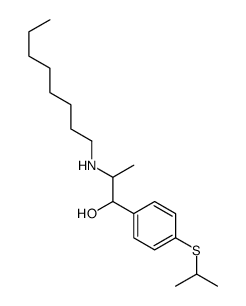Suloctidil

Suloctidil structure
|
Common Name | Suloctidil | ||
|---|---|---|---|---|
| CAS Number | 54767-75-8 | Molecular Weight | 337.56300 | |
| Density | 0.99g/cm3 | Boiling Point | 467.3ºC at 760 mmHg | |
| Molecular Formula | C20H35NOS | Melting Point | 62.5°C | |
| MSDS | Chinese USA | Flash Point | 236.4ºC | |
| Symbol |

GHS07 |
Signal Word | Warning | |
|
A repurposing approach identifies off-patent drugs with fungicidal cryptococcal activity, a common structural chemotype, and pharmacological properties relevant to the treatment of cryptococcosis.
Eukaryotic Cell 12(2) , 278-87, (2013) New, more accessible therapies for cryptococcosis represent an unmet clinical need of global importance. We took a repurposing approach to identify previously developed drugs with fungicidal activity toward Cryptococcus neoformans, using a high-throughput scr... |
|
|
Inhibition of platelet thromboxane generation by suloctidil in man.
Haemostasis 16(5) , 362-8, (1986) Oral administration of 100 or 200 mg suloctidil to healthy volunteers resulted in serum thromboxane B2 (TxB2) inhibition. This reached a maximum level between 90 min and 4 h after drug ingestion. TxB2 levels returned to 75% of basal values 6 h after 100 mg an... |
|
|
Effects of the antithrombotic drug suloctidil on low density lipoprotein processing and cholesterol metabolism in cultured human fibroblasts.
J. Clin. Chem. Clin. Biochem. 26(1) , 3-6, (1988) Human foetal lung fibroblasts were pretreated for 24 h with the antithrombotic drug, suloctidil (1 to 10 mumol/l), which induced a dose-dependent increase in LDL binding, uptake and degradation. At 10 mumol/l suloctidil, the respective increases in these para... |
|
|
Suloctidil-induced hepatotoxicity.
Gastroenterology 95(2) , 490-1, (1988) Suloctidil is a new drug that is currently being evaluated in many clinical trials for use in dementia and thrombotic disorders. Hepatotoxicity has to date been reported exclusively in the European literature, and the few available histologic descriptions hav... |
|
|
Suloctidil hepatitis: a case presentation.
Ir. J. Med. Sci. 156(10) , 290-1, (1987)
|
|
|
Effect of suloctidil on tomographically quantitated platelet accumulation in Dacron aortic grafts.
Am. J. Cardiol. 58(1) , 152-6, (1986) Platelet deposition contributes to the thrombotic and embolic complications of prosthetic materials in man. To determine if the investigational platelet inhibitory drug suloctidil (200 mg 3 times daily) reduces platelet deposition on Dacron aortic grafts, a r... |
|
|
Taurine interferes with spiperone binding in the striatum.
Neuroscience 19(3) , 1007-10, (1986) The effects of taurine and its structural analogues and two new anticonvulsant derivatives, taltrimide and MY-103, on the function of brain dopaminergic systems were studied by assessing their interference with the binding of [3H]spiperone to synaptic membran... |
|
|
1H-NMR study of suloctidil-A23187 calcium ionophore interaction.
Chem. Biol. Interact. 86(2) , 163-9, (1993) Suloctidil is a molecule with calcium antagonist properties, whose anti-ionophoretic effect has previously been reported. In the presence of A23187 calcium ionophore free acid (A+), the NMR spectra of suloctidil (S +/-) are modified at the level of H-1 proton... |
|
|
Glucose- and K(+)-induced acidification in different yeast species.
Folia Microbiol. (Praha) 44(3) , 295-8, (1999) The process of acidification of the external medium after addition of glucose and subsequently of KCl to a suspension of yeast cells varies substantially from species to species. After glucose it is most pronounced in Saccharomyces cerevisiae and Schizosaccha... |
|
|
Antithrombotic activity of suloctidil.
Thromb. Res. 4 , 53-8, (1983)
|